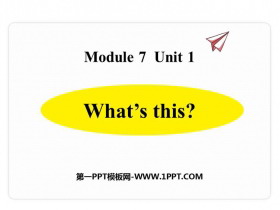



《Language in use》Wonders of the world PPT课件
Objectives:
To summarise and consolidate tenses learned before:
1) the present simple tense
2) the past simple tense
3) the future simple tense
4) the present continuous tense
5) the past continuous tense
6) the present perfect tense
语法讲解建议采用归纳法,如尽可能多的呈现一些相关例句,或可让学生从已学课文中找相应例句,引导学生试着从所观察到的语言现象中总结出语法规律。
... ... ...
Observe
Observe the following examples carefully. They are all from this module.
1. I visited the Giant’s Causeway two years ago.
2. It produces electricity for millions of people in China.
3. I’ve never seen it, so I’m not sure I agree with you.
4. I looked to the east — the sky was becoming grey.
5. You’ll get there in five minutes.
6. Am I going the right way?
7. The sun rose behind me and shone on the rocks.
8. I think the Giant’s Causeway is the most fantastic natural wonder.
... ... ...
Guessing game
1. To test your sense of observation
2. To test your ability of short-term memory
3. To test your ability of inductive method
Ready?
1. I ______ (visit) the Giant’s Causeway two years ago.
2. It ________ (produce) electricity for millions of people in China.
3. I _____ ______ ______ (never see) it, so I’m not sure I ______ (agree) with you.
4. I _______ (look) to the east — the sky ______ ________ (become) grey.
5. You ______ ______ (get) there in five minutes.
6. _____ I ______ (go) the right way?
7. The sun ______ (rise) behind me and _______ (shine) on the rocks.
8. I think the Giant’s Causeway _______ (be) the most fantastic natural wonder.
... ... ...
动词的时态
不同时间和方式发生的动作或状态要用谓语动词的不同形式来表示,这种表示动作或状态发生时间和方式的动词形式称作动词时态。
到目前为止,我们已学过英语中常用的六种时态:
①一般现在时 ②一般过去时
③现在进行时 ④过去进行时
⑤一般将来时 ⑥现在完成时
①一般现在时
表示经常性发生的动作、存在的状态、日常行为、爱好、习惯性动作或客观真理、科学事实等。
I go to school at 6:30 every morning.
我每天早上六点半去上学。
The girl sings very well.
那个女孩唱得非常好。
... ... ...
实义动词第三人称单数的变化规则
1. 直接在动词后+s
like - likes play - plays
2. 以s, x, sh, ch接尾的动词:+es
wash-washes
3. 以辅音+o接尾的动词:+es
do - does go - goes
4. 以辅音+y接尾的动词:变y为i+es
fly-flies
... ... ...
②一般过去时-动词过去式变化规则
1. 一般在动词末尾加-ed,如:pull-pulled, cook-cooked
2. 结尾是e加d,如:taste-tasted
3. 末尾只有一个元音字母和一个辅音字母的重读闭音节,应双写末尾的辅音字母,再加-ed,如:stop-stopped
4. 以“辅音字母+y”结尾的,变y为i, 再加-ed,如:study-studied
5. 常用不规则动词过去式:
am/is-was are-were
do-did see-saw say-said give-gave
get-got go-went come-came have-had
eat-ate take-took run-ran sing-sang
put-put make-made read-read
write-wrote draw-drew drink-drank
fly-flew ride-rode speak-spoke
sweep-swept swim-swam sit-sat
... ... ...
②一般过去时--用法
1.表示过去某个时间发生的动作或存在的状态。
He said that here yesterday.
I got up at six thirty yesterday morning.
My father wrote a passage yesterday afternoon.
Did you have a good time last summer?
2. 表示过去经常或反复发生的动作。
My father often went to work by bus last year.
When I was a child, I often listened to music.
... ... ...
Past continuous tense with‘while’ ,‘when’and‘as’
when, while和as这三个词都有“当……时候”的意思。
While Mille was watching TV, her mum was sleeping.
米莉在看电视时,妈妈在睡觉。
I saw a traffic accident as I was riding to school this morning.
今天早晨我骑车去学校时看到一起交通事故。
Was he doing his homework when the teacher came in?
当老师进来时,他正在做作业吗?
【拓展】
现在进行时可以表示将来的动作,同样,过去进行时也可以表示从过去某时看来将要发生的动作。
Lucy arrived in Beijing last Friday, but she was leaving for Hong Kong the next morning.
上周五露西到达北京,但第二天早晨就要动身去香港了。
... ... ...
1.Explain the differences in meaning between Sentences a) and b).
1 a) I often play basketball.
b) I am playing basketball now.
2 a) She has gone to the Great Wall.
b) She has been to the Great Wall.
3 a) They had an English class yesterday.
b) They were having an English class at nine o’clock yesterday morning.
4 a) He is doing an interview.
b) He has done an interview.
5 a) We are drawing a picture of Victoria Falls now.
b) We will draw a picture of Victoria Falls.
... ... ...
2.Complete the sentences with the correct form of the words in the box.
appear finish give rain talk visit walk
1. listen! It _______ outside.
2. The great musician _______ a concert in Guangzhou next month.
3. Last summer, my parents _______ the Terracotta Army in Xi’an.
4. He _____ already _______ a new book about travel.
5. Thousands of people _______ along the Great Wall every year.
6. A few minutes later, a stranger ______ at the end of the street.
7. The students ________ about the journey to the Grand Canyon when the teacher came into the classroom.
... ... ...
Ⅰ. 用括号内所给动词的适当形式填空。
1. Mr Wang is our maths teacher and he _______ (go) home once a month.
2. Listen! Who ________ (cry) in the next room?
3. Jane ________ (water) the flowers in the garden at this time yesterday.
4. I ________ (use) this pen for a long time but it’s still good.
5. The Kings _____________ (visit) a friend of theirs next week.
6. You _____still ________ (read) a novel! But it’s time for the meeting.
7. They __________ (know) each other since they were young boys.
Ⅱ. 单项选择
1. Liu Yang ______ Hong Kong three times already.
A. was in B. went to
C. has gone to D. has been to
2. — When Tom ______ here, we will finish the work.
— I’m afraid so.
A. will get B. gets
C. got D. is getting
3. — Where _____ your cousin _____ two years ago, Lucy?
— In Changchun.
A. did; work B. does; work
C. has; worked D. will; work
4. — ______ you ______ him anywhere before?
— Yes, but I can’t remember where I ______ him.
A. Did; meet; met B. Have; met; met
C. Did; meet; have met D. Have; met; have met
... ... ...
Homework
1. Finish the exercises in Learning English.
2. Preview the new words and expressions in Module 2.
3. Search for some information about public holidays.
关键词:《Language in use》教学课件,外研版九年级上册英语课件,九年级英语幻灯片课件下载,《Language in use》PPT课件下载,.ppt格式












